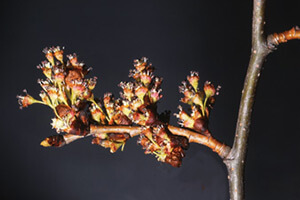Archived Columns
Elm (Ulmus americana)

Scientific name: Ulmus americana (Ulmaceae)
Synonyms: Ulmus floridana
Origin: North America
The USDA Plants Website[18] lists five native Ulmus species. I have chosen to write primarily about Ulmus americana for several reasons. In the beekeeping literature where the full species name is provided, it is this species that seems the most often mentioned. It is naturally widely distributed and has also been planted extensively in areas outside of its original native habitat. The story associated with this species also suggests some lessons to be learned that I consider interesting as well as important.
Because of the tree’s shape, it is a lovely and useful landscaping tree and has been much planted in North America. Unfortunately, it is this last feature (essentially planting as monocultures) that has helped lead to its major demise, Dutch Elm Disease. This in itself is an interesting story from which there are important lessons to be learned. Some of this is described at the end of this writing,
Because of the tree’s shape, it is a lovely and useful landscaping tree and has been much planted in North America. Unfortunately, it is this last feature (essentially planting as monocultures) that has helped lead to its major demise, Dutch Elm Disease. This in itself is an interesting story from which there are important lessons to be learned. Some of this is described at the end of this writing,
Plant description:
American elm, also sometimes called white elm or water elm is a large tree that can grow to 60 or 80 ft or more in height and have a spread of 1/2 to 2/3 or more of its height. Michael Dirr[5] states that at the time (1998) the national champion was 112 ft tall and was located in Copemish, MI.1
The leaves are placed alternately on their stems and are an elongate-oval shape that tapers to a sharp point. They range in length from 3 to 6 inches, are acuminate2 and doubly serrate3 and have 13 to 18 pairs of lateral veins. The shape of the leaf on each side of the central vein is generally not symmetrical. One of the leaf blades usually advances further down the central vein than the blade on the other side. This is often a little more pronounced than is shown by the leaf in the margin. The leaf stems are slender, round, reddish4, and at first pubescent and may or may not be maintained through the year. The leaf scars are marked with three distinct bundle scars that are located so that with some imagination, one can feature seeing a cat face in each leaf scar.
American elm flowers occur before the leaves, are usually perfect5, and occur on long, slender, drooping stems about 2.5 cm (~1 in) long that are arranged in groups of 3 or 4. The anthers are bright red, the ovary and styles are light green, and the calyx is green-tinged, becoming red above the midpoint[5].
John Lovell[9] states that the purplish flowers are wind-pollinated and appear in the spring before the leaves. He also claims that they are partly perfect and partly unisexual. Barnes and Wagner[2] indicate that they are largely perfect. (Dirr[5] simply states they are perfect.
Plant Distribution: See map
Blooming period: The flower buds swell early in February in the South and as late as May in Canada. The flowers appear 2 to 3 weeks before leaf flush and are largely wind pollinated. Soon after pollination occurs, the fruit ripens, and seed fall is usually complete by mid-March in the South and mid-June in the North.
The process of flowering, seed ripening and seed fall in American elm takes place in the spring throughout its normal range.
Importance as a honey and pollen plant: The beekeeping literature concerning the source of honey from elm is a little unclear. There are several species of elm and reports in the literature often identify only elm or the genus Ulmus so the first factor may be that the reports represent different species. A second factor is that elm often has insects (aphids, scales etc.) feeding on its leaves that produce honeydew and the reported honey harvests may actually be from honeydew rather than nectar. This is dealt with in more detail later.
From his extensive questionnaires sent to US beekeepers, Oertel[12] found Ulmus Americana, and U. fulva to be important in Nebraska, U. crassifolia and U. pubescens to be important in TX, and Ulmus (species unspecified) to be important in 20 states (AL, AR, CA, CO, FL, IA, ID, IL, IN, KY, LA, MA, ME, MN, MO, NC, NE, NH, OH, and OK). Robinson and Oertel[15] in their Table 2 indicated that elm was important for both nectar and pollen in their Northern and Southern Plains, Mountain regions and both Eastern and Western Canada, and to be important for only pollen in their Pacific region, thus leaving only their southwest region showing no importance. The topic of whether honey is produced from nectar or honeydew is dealt with in some detail later.
Ayers and Harman[1], from their questionnaires sent to North American beekeepers considered to be knowledgeable about the important bee forages in their area, found Ulmus serotina to be of some importance in OK. Whether this importance was for nectar or pollen or both was unclear. Ulmus (species unspecified) was reported to be of some importance in all their 14 ecological sections of North America except Alaska, South and Central California, the Interior Northwest (parts of eastern Washington, Oregon and south central British Columbia), Northern Great Lakes and contiguous parts of Southern Canada.
From the beekeeping literature there seems to be little doubt that American elm (Ulmus americana) provides pollen for bees. John Lovell[9] indicates that the purplish flowers appear in the spring and are partly perfect …
Photo Caption
Ulmus americana in flower. Photo taken on the Michigan State University Campus in East Lansing MI. on 4/12/2002.


